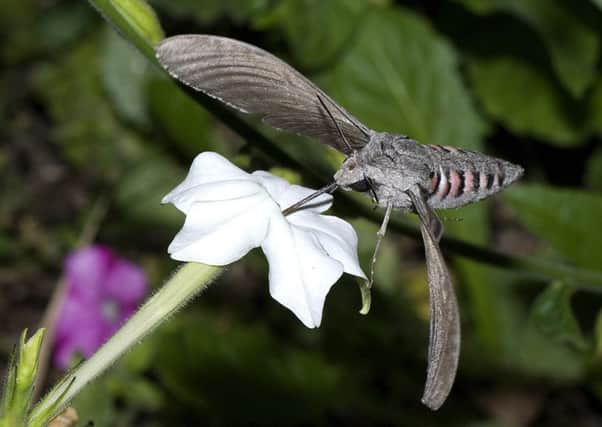Giant moths are on the move!


Moth-lovers are hoping to attract the palm-sized Convolvulus Hawk-moth into their gardens as part of Moth Night, an annual event led by wildlife charity Butterfly Conservation.
With a 12cm wingspan, the Convolvulus is one of the largest moths found in Europe and migrates from North Africa, yet it is capable of pin-point precision flight as it hovers to drink nectar from deep tubular Nicotiana flowers using its amazingly long 7.5 cm proboscis.
Advertisement
Hide AdAdvertisement
Hide AdA chance to see this impressive moth and a number of other species is taking place on Friday and Saturday, September 11 and 12, at the Woodside Walled Garden near Ancrum from 6.30pm.
Moth night is all about raising awareness of the UK’s moth species, many of which have suffered huge declines during the last 40 years, with three species becoming extinct in the last decade.
This year the theme is on migrant species like the Convolvulus, as sightings will help build a clearer picture of moth migration into the UK and the effects of climate change on UK moth populations
Butterfly Conservation’s head of recording, Richard Fox, said: “It has already been an amazing year for moth immigration and such activity usually peaks in early autumn. With migrants such as the massive Convolvulus Hawk-moth mixing with beautiful home-grown autumnal species, Moth Night is a great opportunity to discover the hidden wonders of our nocturnal wildlife at a public event or even in your own back garden.”
Advertisement
Hide AdAdvertisement
Hide AdOther spectacular immigrants to look out for include Death’s-Head Hawk-moth and Crimson Speckled along with the Vestal, which are all borne in from hotter parts of Europe and even Africa on warm winds.
Immigrant moths will come to moth-traps, but can also be attracted by hanging out ropes soaked in wine – a practice known as wine roping.
Another moth attracting technique, known as sugaring, involves painting a mixture of sugar, syrup and beer onto a post or tree trunk.
Moth recorders at UK migration hotspots have also been colour marking some moths caught in the weeks leading up to Moth Night and the organisers will be asking people to keep an eye out for marked moths in the hope that it might reveal more information about insect migration.
Moth Night 2015 runs from September 10-12 and will include night time moth trapping events across the UK.